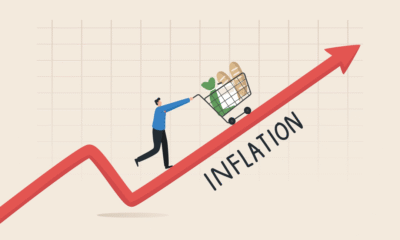Finance and Economy
France Pushes Eurozone Toward Joint Eurobond Issuance

In a bold move that could redefine the financial architecture of the European Union, France has renewed its push for the issuance of joint eurozone debt instruments – commonly referred to as Eurobonds – as a way to strengthen the euro on the global stage. As the EU prepares for its upcoming summit on June 26-27, the proposal is once again stirring heated debate among member nations. French officials argue that a shared debt mechanism is essential not only for financial resilience but also for elevating the euro’s standing as a credible alternative to the U.S. dollar. While the idea garners support from key institutions like the IMF and the ECB, resistance from fiscally conservative member states continues to block consensus. This article explores the implications of France’s proposal, the potential benefits and challenges of Eurobond issuance, and the evolving role of the euro in a multipolar financial world.
France’s Strategic Case for Eurobonds
French President Emmanuel Macron and Finance Minister Bruno Le Maire have long been advocates for deeper EU financial integration. According to them, Eurobonds would represent a tangible step toward fiscal solidarity and monetary cohesion, allowing member nations to borrow at collectively favorable rates while demonstrating political unity. The latest push comes at a time when the European economy is facing several headwinds: slowing growth, fragmented recovery across member states, and heightened global financial volatility triggered by geopolitical conflicts and energy insecurity. Macron has reiterated that a common debt tool is essential for financing major EU-wide projects such as green energy transition, digital infrastructure, and military defense.
From a strategic standpoint, France views Eurobonds as more than just a financial mechanism – they are a symbol of EU credibility and resilience. By pooling risk and aligning borrowing capacity, the eurozone could present a united front in capital markets, reducing the vulnerability of weaker economies and improving the euro’s attractiveness to foreign investors.
The Euro’s Current Global Standing and Its Challenges
Despite being the world’s second most-used currency, the euro still lags far behind the U.S. dollar in terms of global reserve share, trade settlement, and safe-haven preference. Analysts point out that one of the primary reasons for this is the fragmented nature of the eurozone bond market. Each country issues its own sovereign debt, leading to a lack of a single, risk-free eurozone bond benchmark – unlike U.S. Treasuries, which offer deep liquidity and low risk.
France’s proposal seeks to address this imbalance. A unified Eurobond market could create a highly liquid, stable, and scalable financial product that would attract central banks, pension funds, and sovereign wealth investors. Over time, this could shift more global reserves into euros, boosting the currency’s influence in global trade and finance.
Institutional Support: IMF, ECB, and Market Participants
Key international organizations have thrown their weight behind the idea. The International Monetary Fund (IMF) has suggested that Eurobonds could enhance the EU’s fiscal capacity and crisis response agility. Meanwhile, European Central Bank (ECB) officials, including President Christine Lagarde, have hinted that deeper fiscal integration is necessary for the euro to realize its full potential.
Financial market participants have also shown interest. Asset managers argue that Eurobonds could become a cornerstone of fixed-income portfolios, particularly for investors looking to diversify away from dollar-denominated assets. Some analysts compare the opportunity to the creation of the U.S. Treasury market in the post-war era, which laid the groundwork for the dollar’s global dominance.
Opposition from the Frugal Four and Risk-Sharing Concerns
Despite France’s enthusiasm and institutional support, significant opposition persists from fiscally conservative EU nations, notably Germany, Austria, the Netherlands, and Finland—often dubbed the “Frugal Four.” These countries argue that shared debt would penalize responsible fiscal behavior and open the door to moral hazard, where weaker economies might overborrow under the protection of joint guarantees.
German officials have also cited constitutional constraints and public opposition to any perceived “debt mutualization.” Instead, they advocate for reforms at the national level, more stringent budget controls, and the use of existing mechanisms like the European Stability Mechanism (ESM) for crisis funding.
This divide continues to stall formal negotiations. At the heart of the debate is the question of trust and fiscal governance, as many northern states remain skeptical about the long-term commitment of their southern counterparts to austerity and budget discipline.
Implications for Financial Markets and Investors
If approved, Eurobonds would be a game-changer for European capital markets. They would offer a new safe asset class, potentially rivaling U.S. Treasuries in size and reliability over the long term. For the European banking system, Eurobonds could provide high-quality collateral and improve liquidity conditions, especially for cross-border lending.
Investors are closely monitoring the situation. If the EU takes concrete steps toward joint bond issuance, bond yields across peripheral economies like Italy, Spain, and Greece could compress further, as risk premia shrink in anticipation of shared guarantees. Simultaneously, euro-denominated assets may see a surge in foreign inflows, especially from central banks seeking to rebalance reserve portfolios.
Strengthening the Euro’s Role in a Multipolar World
The geopolitical landscape is increasingly defined by multipolarity, with China, Russia, and the U.S. competing for influence in trade, finance, and security. In this context, the eurozone faces a historic opportunity to carve out a more assertive role. Strengthening the euro through fiscal and capital market integration is seen as essential to counterbalance the dollar’s dominance and reduce reliance on U.S.-led financial infrastructure.
Eurobonds could serve as a financial pillar in this transition. As global investors seek alternatives in a fragmented world economy, the euro’s rise as a stable, investable, and liquid currency backed by joint instruments could bolster its credibility and utility.
A Defining Moment for European Unity
France’s push for Eurobonds is more than just a fiscal proposal – it is a call for political and financial unity in a time of global uncertainty. While the road to consensus is steep, the growing support from institutions, investors, and southern EU members suggests that momentum is building. The upcoming EU summit will be a crucial test of the bloc’s ability to move beyond national interests and toward a shared financial future.
If successful, Eurobond issuance could redefine the eurozone’s role in the global economy, offering new tools for crisis response, economic development, and financial competitiveness. For investors and policymakers alike, this moment marks a critical juncture – either Europe seizes the opportunity to lead, or it risks remaining a secondary player in a rapidly evolving financial world.
Economics
Asia’s Private Credit Boom: What It Means for Retail Investors

The Asia Pacific region is witnessing an extraordinary surge in private credit, transforming the financial landscape significantly. Private credit refers to direct lending to companies outside public markets, and over the last decade, this sector’s assets under management have grown from around $500 million to nearly $2 trillion. This rapid expansion is largely driven by emerging markets such as India and Australia, where businesses increasingly seek alternative financing solutions beyond traditional bank loans and public debt offerings. Historically, private credit has been dominated by institutional investors including pension funds and private equity firms. However, the landscape is evolving as retail investors gain access to this asset class through changing regulations, fintech platforms, and increased market demand. The expanding private credit market now offers retail investors an opportunity to diversify their portfolios and participate in an asset class that has demonstrated strong returns and resilience.
Why Private Credit Appeals to Retail Investors
Private credit has grown in popularity due to its potential to offer higher returns compared to traditional fixed-income investments such as government bonds or corporate debt. This is because private credit involves lending to companies with less liquidity and higher credit risk, factors that typically command a premium in yields. Retail investors often face challenges like low interest rates on savings and volatile stock markets, making private credit an attractive alternative for income generation and diversification. The growing involvement of financial giants such as JPMorgan Chase, which has recently allocated over $50 billion into the Asia Pacific private credit market, highlights the confidence that institutional investors have in the asset class. This institutional interest helps validate the opportunity for retail investors to explore private credit as part of a balanced investment strategy that supports both income goals and risk mitigation.
Regional Drivers Behind Asia’s Private Credit Boom
Asia’s private credit growth is closely tied to specific market conditions and regulatory environments within the region. In India, the tightening of banking regulations and a rise in non-performing assets have created a financing gap that private credit funds are actively filling. This has allowed companies to access capital through more flexible and tailored lending arrangements. Meanwhile, Australia’s advanced financial system and regulatory framework support a vibrant ecosystem of private credit funds and alternative lending platforms. These developments offer retail investors in these markets a variety of ways to participate in private credit. Investors can access this asset class through private debt mutual funds, alternative asset management platforms, and regulated digital lending marketplaces. Nevertheless, understanding the regulatory landscape and investment vehicle structures is critical to ensuring compliance and aligning investments with personal risk tolerance.
Key Risks and Considerations for Retail Investors
While private credit offers appealing opportunities, it is important for retail investors to be aware of its unique risks and challenges. Unlike publicly traded securities, private credit investments often involve longer lock-in periods during which liquidity is limited. This means investors may not be able to access their funds quickly, which could be a disadvantage for those requiring flexible cash flow. Additionally, private credit carries credit risk, meaning the possibility of borrower default can impact returns. Transparency is typically lower in private credit compared to public markets, so investors should diligently assess the quality and track record of the fund managers or platforms offering these investments. Understanding the underlying borrower profiles and loan terms is essential to mitigate potential losses. Fees can also be higher due to the complexity involved in underwriting and managing private loans. For these reasons, retail investors should perform comprehensive due diligence, seek professional advice, and only allocate a suitable portion of their portfolios to private credit.
The Role of Education and Professional Guidance
Given the complexities of private credit investing, education and expert advice are indispensable for retail investors. Keeping abreast of regulatory changes, market trends, and emerging opportunities is vital to making informed decisions. Awareness of how alternative investments are regulated in different countries within Asia Pacific helps avoid compliance issues and ensures access to legitimate investment products. Many financial advisors recommend that retail investors allocate a moderate portion of their investment portfolios to private credit as a way to enhance income and reduce correlation with traditional asset classes. However, this allocation should reflect an investor’s financial goals, risk appetite, and liquidity needs. Partnering with experienced fund managers or licensed investment platforms can provide additional safeguards and insights into this relatively complex market.
Supporting Regional Economic Growth Through Investment
Investing in private credit is not only about financial returns; it also plays an important role in supporting economic growth in Asia Pacific. Private credit financing helps small and medium enterprises (SMEs), startups, and infrastructure projects secure the capital they need to expand operations, innovate, and create jobs. Retail investors who participate in this market contribute indirectly to these positive economic outcomes, fostering development and entrepreneurship across the region. This dual benefit of combining financial gains with social impact adds an appealing dimension to private credit investment. It allows investors to align their portfolios with broader economic progress and community development goals, enhancing the meaning and satisfaction derived from their investments.
Conclusion: Unlocking Opportunities in Asia’s Private Credit Market
In summary, the Asia Pacific private credit boom offers an exciting and valuable opportunity for retail investors ready to explore alternative asset classes. The rapid market growth, strong institutional backing, and improving regulatory frameworks create a conducive environment for investment. However, retail investors must remain cautious and informed, understanding the risks related to liquidity, credit, and transparency. A well-researched and diversified approach, combined with professional guidance, can help investors unlock the benefits of private credit while managing potential downsides. As private credit continues to mature and gain accessibility, it is expected to become a vital part of diversified investment portfolios, offering both attractive financial returns and meaningful economic impact across the region.
Finance and Economy
Oil Price Spike as Middle East Conflict Deepens: A Global Market Wake-Up Call

The financial world is once again on high alert as escalating tensions in the Middle East have triggered a sharp surge in global oil prices, sending shockwaves through equity, commodity, and currency markets alike. With the U.S. reportedly striking Iran’s nuclear sites, Brent crude surged over 18%, nearing $80 per barrel in a matter of hours. The sudden volatility reignited fears of a potential $100 oil scenario, reminiscent of past geopolitical flashpoints that deeply impacted global supply chains, inflation expectations, and central bank policy stances. This article delves into the causes, consequences, and global financial implications of this emerging crisis.
The Trigger: U.S. Strikes on Iran’s Nuclear Infrastructure
On June 21, 2025, international news outlets confirmed that U.S. military forces had targeted Iranian nuclear facilities in what they described as a “pre-emptive defensive measure.” While the full extent of the damage is still being assessed, the attack has clearly escalated tensions in an already volatile region. The Middle East, being a vital hub for global oil production and shipping, plays a significant role in maintaining supply stability. Iran, which controls access to the Strait of Hormuz – a key chokepoint through which nearly 20% of the world’s oil supply passes—responded with threats to close the strait and intensify its military posturing. This heightened the risk premium in energy markets virtually overnight.
Oil Prices React Swiftly to Geopolitical Instability
Crude oil, especially Brent and West Texas Intermediate (WTI), reacted with extreme sensitivity to the developments. Brent crude jumped over 18% within a 24-hour period, while WTI saw a comparable surge. Analysts at Goldman Sachs and JPMorgan warned that if the Strait of Hormuz were to be blocked, prices could surpass $100 per barrel within weeks. The last time the oil market saw such an intense geopolitical premium was during the 2019 drone attacks on Saudi oil facilities. However, the current situation has a more severe undertone due to the involvement of nuclear assets and direct military strikes between two powerful adversaries.
Safe Haven Assets Soar as Risk Appetite Declines
As is common in times of geopolitical crisis, investors flocked to safe-haven assets such as gold, the U.S. dollar, and U.S. Treasuries. Gold climbed above $2,400 per ounce, a level not seen in years, while the U.S. dollar index rose nearly 2% as capital fled emerging markets and riskier assets. Meanwhile, 10-year U.S. Treasury yields fell sharply, reflecting a surge in demand for perceived low-risk instruments. Cryptocurrency markets, particularly Bitcoin, experienced a brief rally as some investors viewed digital assets as alternative stores of value, although that rally quickly reversed amid broader market instability.
Stock Markets Face Broad Sell-Off, Led by Energy-Sensitive Sectors
Equity markets around the globe responded negatively. The S&P 500 and NASDAQ both dropped over 2.5% in intraday trading, led by declines in consumer discretionary, industrials, and airline stocks, which are highly sensitive to fuel price increases. European indices such as the FTSE 100 and DAX also saw steep losses, while Asia-Pacific markets like the Nikkei 225 and Hang Seng Index fell sharply as investors priced in a higher global risk premium. Interestingly, energy stocks provided the only bright spot in an otherwise red sea of market activity, with companies like ExxonMobil and Chevron posting strong gains on expectations of rising revenues.
Inflationary Pressures Could Derail Central Bank Strategies
The surge in oil prices couldn’t have come at a worse time for global central banks. After years of battling inflation through aggressive interest rate hikes, many central banks had only just begun to pause or consider rate cuts in 2025. However, higher energy prices feed directly into inflation, particularly in transport, manufacturing, and agriculture sectors, potentially forcing monetary authorities to reverse their dovish pivot. The European Central Bank (ECB), which had recently initiated its first rate cut in years, may now face pressure to hold off on further easing. Similarly, the Federal Reserve, which had opted to maintain its current rate in the last FOMC meeting, is likely to adopt a more hawkish tone moving forward.
Emerging Markets Bear the Brunt of the Crisis
The fallout from spiking oil prices is especially damaging for emerging markets, which are typically more sensitive to commodity price fluctuations. Countries like India, Turkey, and South Africa, which are major oil importers and have significant current account deficits, saw their currencies depreciate against the dollar. This adds to inflationary pressures and increases the cost of dollar-denominated debt, complicating fiscal and monetary policy responses. Foreign institutional investors also withdrew capital from these markets, adding to equity market stress and further depressing sentiment.
Global Economic Growth at Risk
Economists are revising down global GDP forecasts amid fears that higher oil prices will dampen consumer spending, elevate production costs, and destabilize corporate earnings. According to the IMF, a sustained oil price above $90 could reduce global GDP growth by 0.5% annually, with some regions like Southeast Asia and Sub-Saharan Africa experiencing even greater negative impacts. Supply chains, already recovering from post-pandemic disruptions and trade tensions, now face renewed uncertainty due to potential shipping bottlenecks in the Persian Gulf.
Outlook: What Comes Next for Markets and Policymakers?
Going forward, much depends on how the situation in the Middle East evolves. A de-escalation through diplomatic channels, possibly via UN or EU mediation, could stabilize oil prices and soothe market nerves. On the other hand, if Iran follows through on its threat to block the Strait of Hormuz or retaliates militarily, the crisis could escalate into a full-blown regional conflict with severe repercussions for global trade and energy supply. Policymakers worldwide are monitoring the situation closely, and emergency meetings by OPEC and G20 finance ministers are already being planned. The International Energy Agency (IEA) has also signaled its willingness to release strategic petroleum reserves if needed to calm markets.
The Road Ahead is Uncertain but Manageable
In the face of rising geopolitical tensions and economic uncertainty, investors are advised to adopt a cautious, diversified approach. While markets remain volatile and unpredictable, sound investment principles – such as maintaining a balanced portfolio, avoiding over-leveraged positions, and focusing on long-term fundamentals – remain more relevant than ever. The oil price spike triggered by the U.S.-Iran conflict is a potent reminder of how global politics and finance are deeply intertwined, and why staying informed and agile is critical in today’s interconnected world.
Finance and Economy
Navigating the U.S. Finance Market: Trends, Challenges, and Opportunities

Introduction to the U.S. Finance Market
The U.S. finance market plays a crucial role in both the national and global economy, acting as a vital catalyst for economic growth and development. Its significance is illustrated through various key components, including banks, stock markets, real estate facets, and diverse financial services. These components are not only interrelated but also contribute to the formation of a robust financial ecosystem that supports both individual and corporate entities.
Banks serve as the backbone of the U.S. finance market. They facilitate a myriad of services such as deposit handling, lending, and wealth management. The commercial banking sector is complemented by investment banks that engage in underwriting, mergers, and acquisitions, thus providing essential capital to businesses for expansion and innovation. Additionally, a strong regulatory framework governs these institutions, promoting stability and protecting consumers, which is pivotal in maintaining trust within the financial system.
The stock markets, particularly the New York Stock Exchange and Nasdaq, act as platforms for capital formation, allowing companies to raise funds through public offerings. This, in turn, fosters economic development by enabling businesses to invest in growth initiatives, spur job creation, and enhance productivity levels. Investors participate actively in these markets, vying for opportunities to grow their wealth through equities and other financial instruments.
The real estate sector also contributes significantly to the U.S. finance market. It encompasses residential, commercial, and industrial properties, driving investment activity and wealth accumulation. Real estate financing, through mortgages and other loans, is integral to economic stability, impacting various demographic aspects, including home ownership and urban development.
Furthermore, a broad array of financial services, including insurance, asset management, and private equity, enriches the finance market landscape. Collectively, these components underline the market’s complexity and importance, setting the stage for a deeper understanding of ongoing trends and challenges within this dynamic environment.
Historical Overview of U.S. Finance Market
The U.S. finance market has undergone significant transformations since its inception, with a series of critical events influencing its evolution. One of the paramount crises was the Great Depression, which began in 1929 and saw a staggering collapse of the stock market. This event led to widespread economic hardship, prompting the implementation of regulatory measures such as the Securities Act of 1933 and the establishment of the Securities and Exchange Commission (SEC) in 1934. These reforms aimed at increasing transparency and establishing greater investor protection, marking a crucial turning point in the landscape of American finance.
Fast forward to the late 20th century, the finanical market witnessed a surge in innovation and the rise of new financial products. The deregulation in the 1980s, particularly in the banking sector, brought about an era of increased competitiveness and a more diversified financial system. However, these changes also set the stage for a significant downturn. The financial crisis of 2008 highlighted systemic risks within the finance market, showcasing vulnerabilities such as excessive leveraging and unregulated derivatives trading. This crisis resulted in the collapse of major financial institutions, necessitating a government intervention with substantial bailout packages to stabilize the economy.
In response to the lessons learned from the 2008 financial crisis, a series of regulatory reforms were introduced, notably through the Dodd-Frank Wall Street Reform and Consumer Protection Act. This legislation aimed to enhance regulation of financial institutions, address risks in the derivatives markets, and establish the Consumer Financial Protection Bureau (CFPB). The changes championed by this act represented a full circle back to a more regulated approach for the finance market, demonstrating how historical events have continually shaped its dynamics.
Understanding the historical context of the U.S. finance market provides valuable insight into current trends and challenges. The evolution from regulation to deregulation and back again serves as a reminder of the delicate balance between fostering innovation and ensuring financial stability.
Current Trends in the U.S. Finance Market
The U.S. finance market is currently undergoing a significant transformation influenced by various trends that are reshaping its landscape. One of the most prominent trends is the rise of fintech companies, which have disrupted traditional financial services by introducing innovative solutions that enhance user experience and accessibility. These technology-driven firms provide diverse financial products, from online lending to robo-advisory services, which cater to a growing demand for financial independence and personalized services.
Another critical development is the increasing adoption of digital currencies. Cryptocurrencies have gained traction as alternative investment vehicles and are being integrated into mainstream financial systems. This shift has prompted regulatory bodies to take a closer look at how these digital assets operate, leading to the establishment of frameworks to ensure their safe incorporation into the finance market. The rise of central bank digital currencies (CBDCs) also highlights the financial sector’s evolving landscape as authorities explore ways to adapt to technological innovations while maintaining monetary stability.
Furthermore, the focus on Environmental, Social, and Governance (ESG) factors in investment strategies has intensified. Investors are increasingly aware of the importance of ethical practices and sustainability, prompting both institutional and individual investors to incorporate ESG considerations into their portfolios. This trend not only reflects a growing demand for accountability among companies but also aligns with a broader societal shift toward responsible investing.
Technology’s impact on trading and investment cannot be overstated. Algorithmic trading, artificial intelligence, and big data analytics are becoming integral to market operations, optimizing decision-making processes and elevating efficiency. These technological advancements facilitate quick access to market data, allowing for more informed investment strategies. In sum, the evolving trends within the U.S. finance market signal a period of disruption and opportunity, with innovation at the forefront of finance’s future.
Key Players in the U.S. Finance Market
The U.S. finance market is a complex and dynamic ecosystem, influenced by various key players each serving distinct but interconnected roles. Among the prominent participants are investment banks, commercial banks, hedge funds, private equity firms, and regulatory bodies. Each entity contributes to the finance landscape and shapes market dynamics through their unique functions and strategies.
Investment banks primarily focus on raising capital for corporations and governments, helping them issue stocks and bonds. They also provide advisory services for mergers and acquisitions, thus playing a critical role in corporate finance. Their expertise in structuring complex financial products enables them to facilitate transactions that can significantly impact market conditions.
On the other hand, commercial banks serve as the backbone of the financial system, providing essential services such as savings and checking accounts, loans, and credit facilities to consumers and businesses. They act as intermediaries in the financial markets, managing deposits and lending excess funds, thus influencing monetary policy and interest rates.
Hedge funds and private equity firms represent alternative investment vehicles that attract high-net-worth individuals and institutional investors seeking higher returns. Hedge funds typically engage in speculative trading strategies, often employing leverage, to capitalize on market inefficiencies. Conversely, private equity firms focus on acquiring or investing in private companies, restructuring them for improved performance before exiting through sales or public offerings.
Lastly, regulatory bodies, such as the Securities and Exchange Commission (SEC) and the Federal Reserve, play a crucial role in maintaining market integrity. They enforce compliance with financial laws, protect investors, and ensure the stability of the banking system. Through oversight and regulation, these entities help mitigate risks that could lead to systemic failures.
Understanding the roles and interactions of these key players is essential for navigating the complexities of the U.S. finance market. Each participant not only operates within its domain but also influences the broader market environment, creating both challenges and opportunities for investors and companies alike.
Regulatory Environment and Its Impact
The regulatory framework governing the U.S. finance market plays a pivotal role in shaping its landscape, influencing various market behaviors and investor protection measures. Central to this framework are key regulations, such as the Dodd-Frank Wall Street Reform and Consumer Protection Act, enacted in response to the 2008 financial crisis. This act aims to reduce systemic risks within the financial system, enhancing oversight through the implementation of stricter capital requirements for banks and establishing the Volcker Rule, which limits speculative investments by financial institutions.
Furthermore, the Securities and Exchange Commission (SEC) serves as a fundamental regulatory body, overseeing securities markets and protecting investors. SEC rules are designed to enhance transparency and uphold fair trading practices, thereby cultivating investor confidence. The SEC also mandates comprehensive disclosure requirements for public companies, ensuring that investors have access to critical information when making investment decisions.
Compliance with these regulations necessitates continuous adaptation among financial institutions, which often results in significant operational costs. Institutions must invest in robust compliance frameworks and regularly update their internal processes to meet evolving regulatory expectations. This can strain resources, particularly for smaller firms that may lack the capacity of larger institutions to earmark funds for compliance initiatives.
Despite the challenges posed by regulatory compliance, a well-regulated market fosters a safer investment environment, which can enhance overall market stability. Investors tend to exhibit greater confidence in markets that are perceived as transparent and equitable, thus creating opportunities for increased capital inflow. In effect, while the regulatory burden can be seen as a challenge, it simultaneously serves to strengthen the integrity of the U.S. finance market, ultimately benefiting both investors and institutions alike.
Challenges Facing the U.S. Finance Market
The U.S. finance market is currently grappling with several significant challenges that are impacting both investors and financial institutions. One of the most pressing issues is market volatility. Fluctuations in stock prices and bond yields can create an unpredictable environment for investors, making it difficult to formulate effective investment strategies. Such volatility can stem from geopolitical tensions, economic indicators, and even social dynamics, often prompting concerns about the stability of the market.
Another critical challenge is economic uncertainty. Factors such as inflation, rising unemployment rates, and shifts in consumer spending patterns can create a cloud of unpredictability that affects investor confidence. Economic indicators often serve as vital signals to institutional investors, but inconsistent reports result in diverging opinions on market direction, thereby complicating decision-making processes. This uncertainty can lead to market hesitance, where individuals and institutions are reluctant to commit capital to investments.
The ongoing trade wars also pose challenges for the U.S. finance market. Tariffs and trade restrictions lead to heightened costs for businesses, while consumers may feel the pinch in terms of higher prices for imported goods. This dynamic can slow economic growth, reducing overall market activity and consumer spending, indirectly affecting financial markets. The uncertainty surrounding international trade relations may deter foreign investment, causing further complications in domestic financial strategies.
Finally, rising interest rates represent a formidable challenge for both borrowers and investors. With the Federal Reserve adjusting rates to combat inflation, the cost of borrowing is increasing. This can discourage loans for consumers wishing to buy homes or finance ventures, thus slowing economic growth. For investors, higher interest rates can lead to lower bond prices and can make it more difficult for companies to achieve profitability, ultimately impacting stock valuations. Together, these challenges create a complex landscape for navigating the U.S. finance market.
Investment Strategies for Navigating the Market
Navigating the U.S. finance market requires a comprehensive understanding of various investment strategies. One fundamental approach is diversification, which involves spreading investments across different asset classes, sectors, or geographic regions. This strategy aims to reduce risk, as it minimizes the impact of any single asset’s poor performance on the overall portfolio. By having a diversified portfolio, investors can better shield themselves from market volatility and create more stable returns over time.
Another essential concept is asset allocation, which refers to the process of determining how to distribute an investor’s capital among various asset categories like equities, bonds, and cash. The choice of asset allocation should align with the investor’s risk tolerance, financial goals, and investment horizon. A well-structured asset allocation plan can help investors maximize their returns while maintaining an acceptable level of risk, tailoring their investment journey to their individual preferences.
Moreover, investors often grapple with the choice between value and growth investing. Value investing focuses on purchasing undervalued stocks that possess strong fundamentals, with the expectation that they will eventually increase in value. In contrast, growth investing targets companies that are anticipated to grow at an above-average rate, regardless of their current price-to-earnings ratios. Each strategy has its merits and can be effective in different market conditions, thus, investors should assess their objectives and market trends when determining which approach to adopt.
Lastly, financial instruments such as options, futures, and exchange-traded funds (ETFs) can be utilized to manage risks effectively. These instruments allow investors to hedge against potential losses while offering opportunities to enhance returns. Understanding how to employ these strategies sustainably is crucial for successfully navigating the U.S. finance market amidst its challenges and opportunities.
Future Outlook for the U.S. Finance Market
The U.S. finance market stands at a crucial juncture, with multiple factors poised to shape its trajectory in the coming years. One of the most significant influences will be the evolving economic policy landscape. As the federal government navigates fiscal and monetary challenges, potential shifts in interest rates and regulatory frameworks can create both opportunities and challenges for financial institutions. For instance, a rise in interest rates could signal increased lending costs, impacting consumer behavior and business investment. Conversely, accommodative monetary policy may support market stability and growth.
Technological advancements are another area of transformation likely to affect the finance sector. Innovations such as artificial intelligence, blockchain, and big data analytics have the potential to enhance operational efficiencies, improve customer experiences, and introduce new financial products. The rise of fintech companies also indicates a growing trend toward digitization, redefining traditional banking and investment services. Financial firms must adapt to these changes or risk losing market share to more agile competitors who can leverage technology to meet customer demands more effectively.
Demographic shifts will further influence the U.S. finance market’s future. As millennials and Generation Z gain purchasing power, their financial priorities, including sustainability and transparency, are reshaping how financial products are developed and marketed. This change will likely compel traditional financial institutions to reevaluate their strategies to align with the values and expectations of these younger generations, particularly in areas such as investment strategies and personal finance management.
In conclusion, the future of the U.S. finance market will be characterized by a dynamic interplay of economic policies, technological disruptions, and demographic trends. Stakeholders in the finance sector must remain vigilant and adaptable to navigate these evolving landscapes effectively.
Conclusion and Final Thoughts
As we have explored throughout this blog post, the U.S. finance market is characterized by its dynamic nature, presenting both opportunities and challenges that individuals and organizations must navigate with care. Key trends such as technological advancements, regulatory shifts, and evolving consumer behaviors have significantly impacted the landscape, ultimately shaping how financial services are delivered and consumed.
In response to these changes, it is vital for stakeholders, whether they are consumers, investors, or financial professionals, to remain informed and adaptable. The ability to understand and anticipate market trends can empower individuals to make informed financial decisions that align with their objectives. For instance, embracing digital innovations can enhance efficiency and engagement in financial transactions, while awareness of regulatory changes can mitigate potential risks. Additionally, the recognition of changing consumer preferences enables entities to tailor their services more effectively, thereby fostering stronger relationships with clients.
Moreover, the challenges we identified, such as economic volatility and cybersecurity threats, underscore the importance of vigilance in the finance market. Stakeholders must be prepared to develop robust risk management strategies to navigate these hurdles successfully. The interplay between these challenges and the identified opportunities creates a complex but favorable environment for those willing to invest time and effort into understanding their implications.
In conclusion, the importance of cultivating a proactive approach in the U.S. finance market cannot be overstated. By staying abreast of trends and adapting strategies accordingly, individuals and organizations can harness the potential of this evolving landscape. As such, it is crucial to reflect on the insights provided in this blog post and consider how they might influence your own financial decisions moving forward.
-

 Finance & Investment6 months ago
Finance & Investment6 months agoEmerging Markets to Watch in 2025: Opportunities and Risks
-

 Technology and Finance8 months ago
Technology and Finance8 months agoThe Future of Quantum Computing in Financial Modeling and Trading
-

 Finance7 months ago
Finance7 months agoUSA Market Trends & Global Finance Insights
-
Finance7 months ago
Navigating Retirement in the Gig Economy: Challenges and Solutions
-

 Finance8 months ago
Finance8 months agoNavigating Personal Finance in the Age of Inflation and High Interest Rates
-

 Economics6 months ago
Economics6 months agoGlobal Markets React to U.S. GDP Contraction: A Comprehensive Analysis
-

 Investing & Finance8 months ago
Investing & Finance8 months agoFractional Investing: The Path to Wealth Democratization
-

 Finance7 months ago
Finance7 months agoTop 10 High-Yield Savings Accounts in the US (2025 Edition)
















